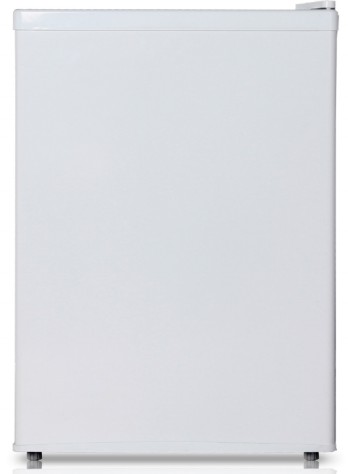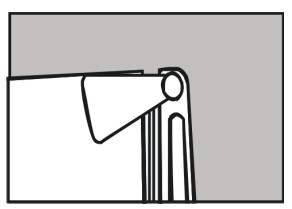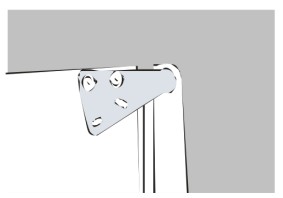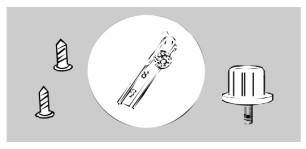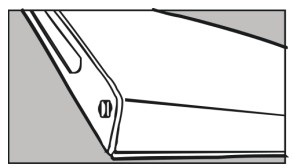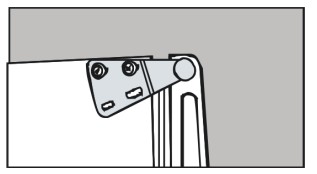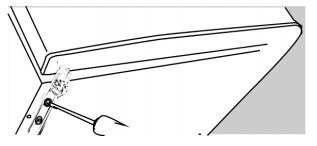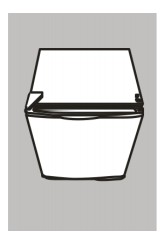
KA69WCBRFGA69L WhiteCold Bar FridgeUSER MANUAL
Attention
|
Please handle this product with care and inspect it regularly to ensure it is in good working order. If the product, power supply cord, or plug shows any signs of damage: stop use, unplug, and contact Kogan.com support. |
Please read this manual carefully. keep a copy handy for future reference.
Safety Warnings
This appliance Is Intended to be used in households, and similar applications such as:→ staff kitchen areas in shops, offices, and other working environments:→ farmhouses and clients in hotels, motels, and other residential type environments; I- bed and breakfast type environments:→ catering and other similar non-retail applications.
- This appliance is not intended for use by persons (including children) with reduced physical, sensory or mental capabilities, or lack of experience and knowledge unless they have been given supervision or instruction concerning the use of the appliance by a person responsible for their safety.
- Children should be supervised to ensure that they do not play with the appliance.
- If the power supply Cord Is damaged, it must be replaced by a Kogan.com technician Or a similarly qualified person in order to avoid a hazard.
- Do not store explosive substances such as aerosol cans with flammable propellants inside.
- Unplug the appliance after use and before carrying out any user maintenance. Keep all ventilation openings clear of obstructions.
- Do not use mechanical devices or other means to accelerate the defrosting process. Do not use extension cords.
- The refrigerant and CyClopentane foaming material used in this appliance is flammable.
- When unplugging the appliance from the power outlet, grasp the plug and pull on it Do not pull on the cord.
- Please use a dedicated power socket for this appliance. Do not share the outlet with other appliances via a power board or double adapter.
- DO not disassemble or attempt to repair the refrigerator yourself. Doing so will void the warranty. Kogan.com is not liable for an appliance that has been tampered with. The gaps between the refrigerator door and the cabinet is small. Do not put your hands in this area to avoid having your fingers pinched.
- Do not touch or move Items from the freezer compartment with wet hands. Do not allow animals or pets to climb into or onto the refrigerator.
- Do not place heavy objects on top of the refrigerator.
- Unplug the unit from the power outlet in the event of a power failure or when cleaning. Avoid plugging the unit back in within the spate Of 5 minutes after unplugging to avoid damage to the compressor.
- The refrigerator should be used only for the storage of household foods and drinks. It is not designed for the storage of blood. drugs or other biological products.
- Do not store beer, beverages, or other fluids contained in bottles or enclosed containers in the freezer compartment of the refrigerator, as the bottles may crack due to the freezing process.
- When the refrigerator is being disposed of, the doors should be removed and the power cord should be cut.
Usage
Placement
Before use, remove all packaging materials, including bottom cushions, foam pads, and tape from inside the refrigerator. Remove any protective films on the doors and body.Place the refrigerator in a location away from heat and direct sunlight. Do not place the freezer in a moist or watery location to prevent rust.Ensure the refrigerator is placed on a stable, flat surface. Make sure the unit cannot be rocked side to side, back and forth or diagonally.Ensure there is at least 20cms of empty space above the top of the refrigerator, plus at least 15cm of space to each side to allow for the dissipation of heat.
Door Space Requirements
The unit’s door must be able to open fully, as shown.

Leveling Feet

There are two leveling feet at the front of the unit.If the unit is not level, the door and the magnetic seal alignments will not be covered properly.
Reversing the Door Swing
Tools required: Phillips head screwdriver, Flathead screwdriver, Hexagonal spanner.
If you wish to have the door swing reversed, it is recommended that you contact a qualified technician. If you believe you are qualified to do so, you may reverse the door yourself.
- Ensure the unit is unplugged and empty.
- Adjust the leveling feet to their highest position.
- To take the door off, it is necessary to tilt the unit backward. You should rest the unit on something solid so that it will not slip during the reversal process.
- All parts removed must be saved to do the reinstallation of the door.
- Do not lay the unit down flat, as this may damage the coolant system.
- It is recommended that 2 people handle the unit during assembly.
- Remove the plastic covering from the top door hinge

- Unscrew the two screws from the bottom bracket. Remove the loot from the CSOOSite Side.

- Place the pieCes off to one side.

- Slide the doer down about IScm, and off the hinge pin then lift it away from the fridge.

- Remove the two screws from the top bracket. and replace them on the other side. You wt need to remove the plastic caps from the Other side first

- Slide the door back onto the top hinge. making sure It is facing the right way up. Screw the bottom hinge into place on the new side. Replace the other loot on the other side. then replace the plastic covering by clicking it back into place on the door hinge.

- Check that the door is aligned horizontally and vertically. and that the seals ate closed on all sides before finally tightening the bottom hinge.

Re.atkust the lveiling feet.
Starting Up
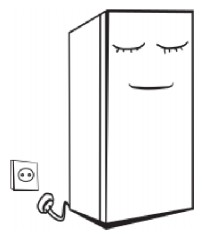
- Before plugging the fridge into a Dower keep the refrigerator still for two hours to give the coolant fluid time to settle.
- Before pitting any fresh or or frozen foods into the fridge, the fridge should be left to run for 24 hours.
Cleaning Before Use
Wipe the inside of the unit down with a weak solution of bicarbonate of soda. Then rinse with warm water, using a damp sponge or cloth. Wash the shelves and salad compartment in warm soapy water, then dry completely before replacing them Into the unit.Clean the exterior of the unit with a damp cloth.
Energy Saving Tips
- This appliance should be located in the coolest area of the room, away from heat sources and heating ducts, as well as away from direct sunlight.
- Let hot foods cool to room temperature before placing them in the refrigerator. Overloading the fridge forces the compressor to run longer. Foods that freeze too slowly may lose quality or spoil.
- Be sure to wrap foods properly, and wipe containers dry before placing them in The will cut down on frost build-up.
- The storage bin should not be lined with aluminum foil, wax paper, or paper toweling. These liners will interfere with the cold air circulation, making the appliance less efficient.
- Organize and label your food to reduce door openings and extended searches. Remove as many items as needed at one time, then close the door as soon as possible.
Structure and function
Key Components
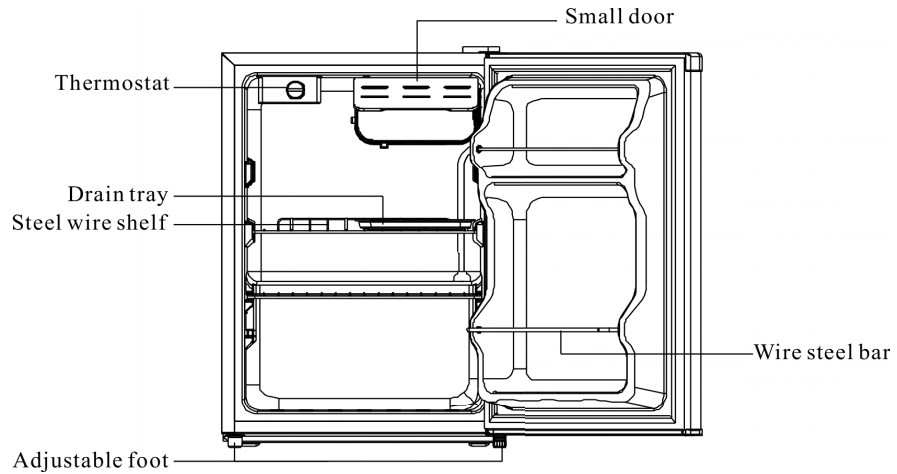
The picture above is for reference only. The actual layout may differ slightly.
- The refrigerator chamber is suitable for the storage Of a variety of fruits, vegetables. beverages and other foods to be consumed in the short term.
- Cooked foods should not be put into the fridge until they have cooled to room
- Foods should be sealed up before being put into the fridge.
- The glass shelves can be adjusted up and down as desired to create suitable storage
Note: the storage of too much food after the initial connection to the power may adversely affect the freezing effect of the fridge. Foods stored must not block air outlets.
Adjusting the Temperature
The temperature selector knob is located on the top of the fridge interior.
- OFF: Turn unit off
- MIN: Mildly cool.
- MED: Normal cooling (suitable for most situations)
- MAX: Coldest temperature possible.
During particularly warm weather, it may be necessary to set the temperature to the MAX position. This may result in the compressor running continuously to maintain the low temperature.
For the first time, you install the refrigerator, set the thermostat to MED. Give the refrigerator time to cool down completely before adding food. You should wait at least 24 hours before placing food inside.
Maintenance and Care
Cleaning
- Dust behind the refrigerator and on the ground should be cleaned to improve the cooling effect and improve energy efficiency. The interior of the refrigerator should be cleaned regularly to avoid odors. Soft towels or sponges dipped in water and non-corrosive neutral detergents are suggested for cleaning. The freeze should be cleaned with clean water and dry cloth. Open the doors and allow the unit to dry naturally before closing the doors and turning the power back on.
- Do not use hard brushes, steel wool, wire brushes, abrasives. organic solvents, boiling water, acids, or alkaline items to clean the refrigerator.
Defrosting
- Unplug the power cord.
- Remove food and store it properly to avoid food spoilage.
- Clear the drain pipe.
- Place down trays to catch the water as the frost melts.
- You can let the freezer defrost using the natural temperature of the room.
- If there is a large amount of ice, an appropriate amount of hot water can be used to speed up the melting process.
- Once defrosted, close the fridge and plug the unit back into a power outlet.
- After a few hours, you are safe to return the food to the freezer.
Out of Operation
- Power Failure: In the event of a power failure. even in summer. the food inside the refrigerator will stay cool for several hours. While the power is out, ensure that the door is not opened and fresh food is not added to the fridge.
- Not In Use: in the event that you will not be using the fridge for an extended period of time, you should unplug the refrigerator from the power outlet and clean it thoroughly. The door should be kept open to prevent odors.
- Moving: Before the refrigerator is moved, you should remove all food Then fix all-glass partitions. vegetable holder. freezer drawers etc. with tape. Tighten the leveling feet, then close the doors and seal them with tape. While moving, the refrigerator must not be turned upside down or laid down.
To improve the longevity of the refrigerator. once it has been set up and turned on, it should be disrupted as little as possible. Starting the unit up and shutting it down, or moving it, will both significantly shorten the life expectancy of the unit.
Troubleshooting
If you experience any issues, please check the table below before contacting our support team.
| Failed Operation | Check that the refrigerator is plugged in. and the outlet is switched on.
Check whether there is a power failure, or if your circuit breakers have tripped. |
| Odor | Ensure that foods with strong scents are well wrapped.
Check whether there is any rotten food or liquids in the fridge. Clean the inside of the refrigerator. |
| The compressor is working for long periods | During summer, it is normal for the compressor to work harder due to the higher ambient temperature.
Ensure that food is allowed to cool down before it is placed inside the fridge. Do not open the doors too frequently. |
| Light not turning on | Check to see whether the fridge is plugged in and that the outlet is switched on. Has the globe been replaced? |
| The door cannot close | Check to see that the door isn’t being blocked by any packaging. Check that the fridge isn’t tilting. |
| Loud noises | Check whether the fridge is stable and level. |
| Door seats aren’t tight | Remove any foreign matter or liquids on the seals.
Heat the door seal with a hot towel or hairdryer, then close the fridge. |
| Water pan overflowing | There is too much food in the freezer, resulting in heavy defrosting. Doors aren’t closing properly, resulting in over frosting. |
| Fridge body is hot | Heat dissipation of the built•In condenser Into the body is normal. |
| Surface condensation | Condensation on the exterior surface and door seals is normal when the ambient humidity is too high. It can be wiped away with a clean towel. |
| Abnormal noise | Buzzing and creaking from inside the body of the refrigerator is perfectly normal. This is the sound of the compressor and the refrigerant flowing. |
The user manual is subject to change without notice. For the latest version of your user manual, please visit https://www.kogan.com/usermanuals/
[xyz-ips snippet=”download-snippet”]


